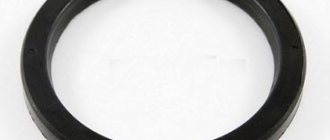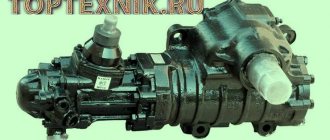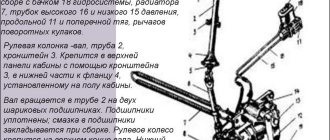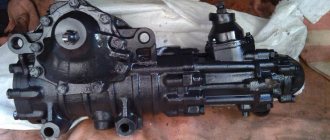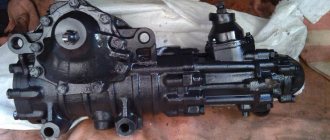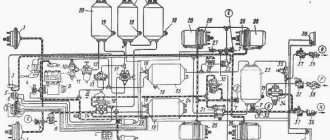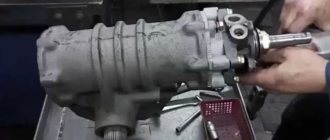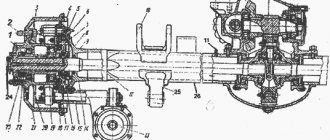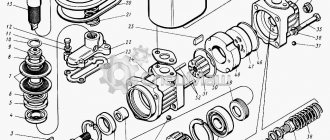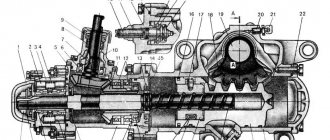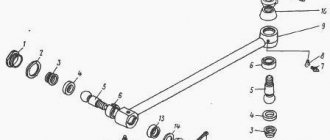Malfunctions of power steering systems, their care and adjustment
Checking the free play of the steering wheel of a KamAZ-5320 vehicle is carried out while the engine is idling. Before you begin adjusting the free play of the steering wheel, you need to check the condition and adjustment of the steering mechanism, play in the cardan joints and the tightness of the driveshaft mounting wedges.
To check the axial play of the steering wheel, it is necessary to move the steering wheel axially up and down. If there is axial play, it is necessary to tighten the nut, first straightening the antennae of its lock washer. After adjustment, bend one of the antennae of the washer into the groove of the nut and check the moment of resistance to rotation of the steering wheel shaft, disconnected from the steering driveshaft. The permissible rotational resistance should be in the range of 0.6-0.8 Nm.
The steering mechanism is checked with the longitudinal steering rod disconnected from the bipod (Fig. 109) and the engine not running. Using a spring dynamometer, measure the force applied to the steering wheel rim in three positions.
Promotional offers based on your interests:
First. The steering wheel is turned more than two turns from the center position. The force on the steering wheel rim should be in the range of 6–16 N.
Second. The steering wheel is turned 3/4 - one turn from the middle position. The force applied to the steering wheel rim should not exceed 22 N.
Third. The steering wheel goes to the middle position. The force applied to the steering wheel rim should not exceed by 4-6 N the force obtained when measuring in the second position of the steering wheel, and should not exceed 27 N.
If the obtained indicators do not correspond to the specified data, then the steering mechanism should be adjusted, starting with setting the amount of force in the third position, using the adjusting screw and first loosening its lock nut (in this case, the steering mechanism does not require disassembly). When turning the adjusting screw clockwise, the force increases, and counterclockwise, it decreases. The tightening torque of the locknut should be 60-65 N * m.
Rice. 109.
Scheme of operation of the power steering of KamAZ vehicles: I – straight forward movement; II – turn right; III – turn left; 1 – steering wheel; 2 – hydraulic system filter safety valve spring; 3 - filter; 4 – power steering pump; 5 - bypass valve; b – bipod shaft with a gear sector, 7 – rear working cavity of the hydraulic booster; 8 — piston-rack; 9 – bipod; 10 – longitudinal thrust; 11 – transverse thrust; 12 – front wheel of the car; 13 – magnetic drain plug; 14 – ball nut; 15 - screw; 16 — steering gear housing; 17 - check valve; 18 — safety valve of the steering mechanism; 19 — power steering control valve; 20 – control valve spool; 21 – thrust bearing; 22 – jet plunger; 23 – centering spring; 24 — angular gearbox; 25 — front working cavity of the hydraulic booster; 26 – discharge line; 27 — cardan shaft; 28 – radiator; 29 – steering column; 30 – filler neck filter; 31 – hydraulic system reservoir; 32 – drain line; 33 – pump bypass valve spring; 34 - pump safety valve; 35 - bypass valve; A and B - throttling holes
After tightening the locknut, the adjustment should be checked again.
The discrepancy between the force on the steering wheel rim in the first and second positions with the above data indicates incorrect adjustment of the steering screw thrust bearings and damage to the parts of the hinge nut assembly. Rotating the bipod shaft from one extreme position to another requires the application of a torque of 98 N. Disassembling the steering mechanism unless absolutely necessary is not allowed. This work should only be performed by a qualified mechanic.
The hydraulic booster safety valve is adjusted on a special stand. At an oil temperature of 70 °C, the valve is adjusted to an opening pressure of 6 MPa.
The pressure developed by the power steering pump is checked using a special device consisting of a pressure gauge and a valve with a tee. The device is connected between the pump and the high pressure hose of the power steering.
The power steering pump pressure is checked at an idle engine speed of 600 rpm.
To check, open the valve by turning the car wheels to the extreme left or right position until they stop. In this case, the pressure developed by the pump must be at least 5.5 MPa. If the pressure does not reach this value, you should slowly screw in the valve and observe the increase in pressure according to the pressure gauge. The absence of an increase in pressure indicates a malfunction in the steering mechanism - incorrect adjustment of the safety valve or large internal oil leaks.
If the pump pressure with the valve closed is greater than with the valve open, but below 6 MPa, then both components are faulty. To check the correct operation of the power steering control valve, you need to disconnect the longitudinal steering rod, open the valve and apply an additional force on the steering wheel of at least 98 N at a crankshaft speed of 1000 rpm.
When removing the force from the steering wheel, the pressure should drop to 0.3-0.5 MPa (no more). Carry out this test in both extreme positions. Insufficient pressure drop indicates a sticking valve. When checking, you cannot keep the valve closed for more than 5 seconds. The temperature in the pump reservoir should be 65–75 °C.
If it is necessary to increase the oil temperature, turn the wheels from one extreme position to the other, holding them in the indicated positions for no more than 15 seconds each time.
Signs of malfunctions in the power steering system
There are several signs that the power steering system is airy, in which case it is necessary to bleed it. Among them:
- the appearance of strong noise in the area where the power steering or its pump is installed;
- increased pressure on the steering wheel , difficulty turning it;
- leakage of working fluid from the power steering system.
In addition, there are several other signs that indicate the system is becoming airy - the appearance of foam on the surface of the working fluid in the expansion tank, spontaneous turns of the steering wheel to one side. If you encounter at least one of the described symptoms, it means you need to bleed your power steering.
Causes of steering play in VAZ 2107
If you notice unacceptable play in the VAZ 2107 steering wheel, the reasons may be as follows:
- The central nut securing the steering wheel to the axle is not tightened;
- the nut securing the steering column to the gearbox is loosened;
- The worm gear of the steering mechanism is not adjusted;
- the steering pendulum bushings are worn out;
- The tie rods are damaged or their ends are worn.
All of these problems require immediate intervention. Otherwise, the steering mechanism may fail and the car will lose control.
Purpose
The main function of the mechanism is to reduce the force required to turn the steering wheel while the truck is moving. That is, the unit provides comfortable control and turning. If the system is faulty, even at low speed you have to exert significant effort, and at high speed, especially when performing maneuvers, control may be completely impossible (even to the point where the steering wheel jams).
Problems that the power steering solves
The main task of any power steering is to make it easier to turn the steering wheel. Without it, even minor turns of the steering wheel would require significant physical effort.
Another task of the KamAZ power steering is to guarantee normal vehicle controllability. In other words, this is an element necessary to ensure a sufficient level of safety during operation of the machine.
How to guarantee safety
The safety of a vehicle on the road requires regular checking of the serviceability of vehicle controls. After all, bumps on the road, impacts, braking and other factors negatively affect the technical condition of the steering controls. Steering play and increased wear of parts negatively affect vehicle controllability and road safety. A knocking sound in the steering column and a worn rack are indicators that it's time to work on the car.
Quite a few car enthusiasts, in order to save money, try to put their car control mechanisms in order with their own hands. If this does not apply to new VAZ cars, and the driver is able to perform the work at a professional level, this approach is acceptable. But, if there is a need to repair and maintain the steering control of modern car models, it is advisable to entrust this work to experienced car service technicians.
Problems solved by KamAZ power steering
Not all passenger cars have power steering. And it’s clear why, cars are quite light and can be driven without power steering. However, try to do this on a heavy KamAZ. On a car that weighs 10 tons without load, it is almost impossible to turn the steering wheel without power steering, unless, of course, you are a weightlifting champion. Therefore, in cases where the amplifier fails, driving the car turns into real torture. And any driver tries to fix it as quickly as possible.
Purpose of the hydraulic power steering
The purpose of power steering is to reduce as much as possible the user's force applied to the steering wheel. In addition, the operation of KamAZ power steering affects stability when driving at low speeds. When moving quickly, in order to avoid an emergency, the amplifier creates additional resistance on the steering wheel. This stabilizes the ride along the road and keeps it on course.
The peculiarity of the power steering on the KamAZ-4310 and other models is that if the mechanism breaks down or fails, control of the vehicle is not lost, but remains in working order. The only drawback is that the user is forced to turn the steering wheel with greater force when turning the vehicle.
Hydraulic power steering KamAZ-760:
The design of a typical KamAZ power steering
Any power steering consists of the following main components:
- distributor;
- Hydraulic cylinder;
- Working fluid;
- Pump.
Modern power steering systems are also equipped with an electronic control unit. A special feature of the KamAZ hydraulic booster is that all its actuators are assembled in one housing. The working fluid is fluid for power steering and automatic transmissions of the ATF type.
The operating principle of power steering is as follows. The main thing to always remember is that the amplifier only works when the power unit is running. It is started by a belt coming from the crankshaft, which drives the pump. On KamAZ trucks, pumps can be rotary or axial piston.
General KamAZ steering device
- steering wheel;
- steering column;
- bracket;
- flange;
- adjusting nut;
- cardan transmission;
- radiator;
- distributor;
- bevel gear;
- steering gear;
- longitudinal steering rod;
- bipod;
- bipod shaft;
- pump;
- tank.
When the engine starts, the pump (14) pumps working fluid from the tank (15). Fluid under high pressure enters a spool-type distributor, which then helps the driver rotate the steering wheel (1).
A special device is used to monitor the force on the steering wheel. On KamAZ, this is a torsion bar, which is located in the section of the steering shafts.
When the car moves in a straight line and there is no force on the steering wheel, then the torsion bar is open and the distributor valves close. In this case, the power steering does not work, and the working fluid is sent back to the reservoir.
When the driver begins to turn, the torsion bar rotates and the spool opens the channels through which the working fluid under pressure is directed to the power steering mechanisms. This makes it easier to rotate the steering wheel.
In cases where the steering wheel is turned all the way, the safety valves open, they relieve fluid pressure and, in essence, turn off the amplifier. This is done in order to avoid damage to the steering mechanism, since the force created by the power steering is quite enough to break it.
We repair and adjust the power steering on a KAMAZ with our own hands
The hydraulic steering control system is an integral part of any KAMAZ, since without it, steering the vehicle will be, if not impossible, then very difficult. Thanks to this unit, the driver can turn the steering wheel with greater ease. You can learn more about what the KAMAZ power steering system is and how to de-air it from this material.
First, let's look at the main characteristics of the power steering on a KAMAZ 6520 or any other model. Let's start with the purpose and device.
Photo gallery “Main elements of the power steering system”
1. KAMAZ power steering switchgear 2. Power steering pump 3. Hydraulic cylinder of the device
Features of the pump
The pumping device is installed in the collapse of the BC. Domestic trucks use a gear top drive, but the device itself is of the blade type. In accordance with the technical documentation, this unit is characterized by double action, that is, with one turn of the steering wheel it carries out two cycles of suction and discharge.
Let's take a brief look at the operating principle. When the wheel turns, the rotor blades begin to rotate, which, in turn, are pressed against the stator device. Working fluid begins to flow into those blades that, when pressed, coincide with the holes on the body. Further, thanks to the same blades, the consumable material enters the narrower holes that exist between the stator and the rotor.
At the moment when the working surfaces can coincide with the holes on the distribution disk, the consumable material will come out beyond it. Next, the oil will pass through the lower valve; for this, high pressure is formed in the system.
The working fluid, leaving the cavity behind the distribution disk, will flow onto the rotor blades, as a result of which they will be pressed even more tightly against the stator plane. The process of pumping the substance, as well as its absorption, is carried out simultaneously in two places.
As the number of revolutions of the rotor device increases, liquid from the surface behind the disk will not pass through the calibration hole.
By creating pressure in the system, the bypass valve is opened, and part of the consumable material, through the manifold, is again supplied to the suction surface (the author of the video about replacing the hydraulic booster on a KAMAZ is Mathur Malay).
Common power steering faults
It must be said right away that repairing KAMAZ power steering is a procedure that our compatriots do not encounter so often. If the driver follows the basic rules for operating the unit, and also carries out its maintenance in a timely manner, then the likelihood that it will fail will be minimized. As practice shows, problems with the performance of the hydraulic booster mainly arise in the cold season. In general, all malfunctions can be divided into mechanical and hydraulic failures, both of which can occur in any part of the device.
As you know, any hydraulic system most often exhibits malfunctions in frosty conditions, in particular, temperature changes.
After all, you need to remember that the pumping device pumps high pressure, so if the viscosity of the liquid in the system increases, this will lead to the squeezing out of the seals and, accordingly, its leakage.
The problem of oil seals is especially evident in cars whose drivers do not follow operating rules, for example, leaving the car in a parking lot with the wheels twisted. This will lead to the fact that after starting the engine, the pressure will increase only on one side, accordingly, the oil seal will squeeze out in any case.
As for the warm season, in summer malfunctions usually appear as a result of dirt and dust getting into the system. If any part is depressurized, the wear of the bushings, as well as the rods, will be faster. Rods usually rust quite quickly, resulting in accelerated wear of the bushings. When operating a car with such a problem, after several hundred kilometers, there will be a large gap between these elements, and this, in turn, will lead to the steering rack starting to make a knock (author of a video about repairing the system in a garage - channel EIGHT ATMOSPHERE).
How to remove an air lock from the system?
The need to bleed the system usually arises after refueling it or eliminating breakdowns in the operation of the unit. Air entering the lines leads to less efficient operation of the hydraulic booster, so the only solution in this case is to remove the air.
So, how to bleed the power steering:
- First you need to move the front axle so that the car's wheels do not touch the ground. Using a jack, you should place supports under the beam on both sides. If the wheels are on the ground, bleeding of the system cannot be started.
- Then you need to remove the filler cap of the expansion tank located under the hood.
- Next, the rubberized cap should be removed from the bypass valve, and an elastic pipe should be installed on its head. In this case, its open part should be lowered into a glass container, the volume of which will be at least half a liter. The vessel itself should be filled halfway with the working fluid.
- Then the bypass valve should be opened slightly, half a turn.
- After completing these steps, turn the steering wheel to the left all the way. After this, the working fluid is poured into the expansion tank until its level decreases.
- Then you need to start the power unit, and while it is operating at minimum speed, pour a little liquid into the expansion tank, but without allowing the level to drop. Do this until bubbles stop coming out of the pipe that is installed on the bypass valve. After this, the valve itself can be closed.
- Next, the steering wheel should be turned all the way to the right, and then to the left. And holding the steering wheel in this position, again unscrew the bypass valve halfway and observe whether bubbles come out of the pipe. When they stop coming out, the valve can be tightened.
- This operation must be carried out several times, ultimately a clear liquid will come out of the valve, in which any impurities or air bubbles should be absent. If bubbles continue to come out, the procedure should be repeated several more times, but do not forget to monitor the volume of working material in the expansion tank.
- Then all you have to do is turn off the motor and remove the pipe from the valve head. Put the cap on the head itself, and then again diagnose the volume of liquid in the tank. If there is a need, it will need to be added. Further assembly of all components is carried out in reverse order.
Power steering KamAZ: device, adjustment
KamAZ is perhaps the most common truck in Russia. Back in Soviet times, the trucks of the Kama Automobile Plant established themselves as reliable, unpretentious and quite comfortable vehicles. Most drivers in the USSR considered it a blessing to work at KamAZ. One of the reasons for this was the presence of power steering (power steering) on the truck, which was an unheard of luxury for the domestic automobile industry.
However, this unit, which greatly facilitates the driver’s work, has to be maintained and also repaired. In this article we will talk about how to do it correctly and when.
Hydraulic booster without fitting
If the hydraulic booster is not equipped with a fitting for bleeding air, the pumping process is performed slightly differently. Initially, operations are carried out with the engine turned off. To do this, the front of the car is hung out. Liquid is poured into the tank to the level. Then you need to turn the steering wheel from lock to lock several times.
Then the car lowers to the ground. Then you will need to start the engine and let it run for a few minutes. Next, the steering wheel must be turned again from the stop, first to the left, then to the right, without stopping in the extreme positions. In this case, you need to monitor the liquid level and top up if necessary.
During this operation, foam forms on the surface of the liquid in the tank. Then you need to stop the engine and wait until the foam disappears. The pumping has been completed.
If you constantly hear noise under the hood, this indicates wear on the bearings of the power steering pump. In this case, the pump is replaced.
Possible faults
The products of the Minsk Tractor Plant are of high quality, excellent technical characteristics and long service life, but over time they may require repairs and adjustments. Owners of MTZ tractors have to deal with several typical power steering breakdowns, which include:
- tight steering;
- the tractor does not turn in the right direction;
- There are delays in the operation of the node.
To eliminate such faults, it is strongly recommended to disassemble the unit and troubleshoot individual elements, and then replace the damaged parts with new ones. After carrying out the work, you will need to install the unit in place, and then adjust it.
Setup and repair
If it is necessary to improve the power steering MTZ 80 or eliminate minor damage, it is enough to perform a detailed adjustment of this mechanism. To do this, it is advisable to adhere to the following instructions:
- Loosen the main bolt located at the worm-sector engagement point.
- Using a wrench, turn the bushing clockwise until it stops, then turn it in the opposite direction by 1-1.2 cm.
- Tighten the main bolt, start the engine and make sure the steering wheel rotates correctly.
- If binding is detected, you will need to increase the engagement gap by turning the bushing counterclockwise.
- Adjust the sector-rail connection by reducing the thickness of the adjusting shims until they stop. The extreme position can be determined by the gap between the rail and the stop, which will reach 0.1-0.3 mm.
- Tighten the thrust bearings using a ball nut, being careful not to over-tighten them.
In addition to adjusting the unit, maintenance may need to be performed to help keep the power steering in optimal condition. Most often, it is necessary to wash the oil filter, which can be done by lifting the lining, dismantling the oil line and cover.
Some breakdowns, such as difficulty turning, may indicate insufficient fluid volume in the hydraulic system, improper adjustment, or worn cylinder o-rings.
How to change oil in power steering Kamaz
To change the power steering oil, you need to bleed it; this action will remove air from the system. Air should not be left in the system.
- First, you need to open the valve on the steering mechanism, it is also called the bypass valve;
- Then compress the centering springs. This can be done by turning the steering wheel to the left all the way;
- Fill the pump with oil;
- The power device must be turned on, and at this time you add oil slowly and gradually, and see if air bubbles come out of the hose. If the bubbles stop coming, that means enough;
- Screw back the bypass valve;
- Again, compress the centering springs, only now you need to turn the steering wheel to the right as far as possible, and the springs should compress, and immediately return it back to the left all the way, again twist the bypass valve to see if any air bubbles are released. After all the air has come out, the valve can be screwed back on;
- Do the action from the previous point until all the air comes out and only oil comes out of the valve.
How to remove an air lock from the power steering system
- Suspend the front axle so that the wheels do not touch the ground. The truck is lifted with a jack and trestles are placed under the beam on both sides;
- Remove the caps from the neck of the tank through which the oil is poured;
- Remove the rubber pads from the bypass valve and fix them on the spherical head of the elastic hose. Place the other end in a glass vessel with a volume of 0.5 liters, half filled with oil;
- Unscrew the bypass valve half to three-quarters of a turn;
- Turn the steering wheel to the left all the way;
- Fill the pump tank with lubricant to a level where it will not drop;
- Start the engine and add oil while rotating the crankshaft at low speed. It is necessary that the oil level does not decrease until the formation of air bubbles stops at the outlet of the hose located on the bypass valve;
- Next, you need to close the bypass valve;
- Turn the steering wheel to the right all the way and back, to the left all the way. Hold the steering wheel in this position and turn the bypass valve half to three-quarters of a turn. Here you also need to control the release of air bubbles. After the air has escaped, the bypass valve closes;
- Repeat step 9 several times. It is important to ensure that clean oil (without air impurities) ultimately comes out of the valve;
- Stop the motor;
- Remove the hose and attach the protective cap to the valve head. Then check the lubricant level in the pump reservoir. If the tie rod was disconnected, you need to reinstall it.
Adjusting power steering KAMAZ
The steering mechanism can only be checked and adjusted in the position when the engine is turned off and the longitudinal steering rod is disconnected.
Before starting work, you need to check the wheel balancing, pressure level, presence of oil in the steering and hubs, settings of wheel bearings and rods, functioning of shock absorbers, quality of installation of the front wheels, oil level in the pump.
To check the force of the steering column, a dynamometer mounted on the wheel rim is used. The force is checked at different positions of the steering wheel: when turning 2 or more turns from the initial position, when turning three-quarters of a turn, when the wheel passes the initial position.
Forces that do not correspond to the specified values in the required positions must be adjusted. This may require dismantling the unit, its partial or complete disassembly:
- First, the adjustment is made in the third position, the adjustment is carried out using the bipod shaft screw;
- Then the first position is adjusted - you need to tighten or loosen the mounting location of the thrust bearings (partial disassembly of the mechanism is required);
- Adjustment in the second position is carried out with complete disassembly of the hydraulic booster.
Ural car steering repair
After completing the assembly of the steering mechanism, check the ease of rotation of the steering shaft; the torque should be no more than 1.2 kgf-m. It is necessary to disassemble steering components and mechanisms only if absolutely necessary. The work must be carried out by qualified mechanics in completely clean conditions.
Dismantling the steering control of a Ural car
It is recommended to disassemble the steering mechanism in the following order:
- remove the steering bipod, support washers, oil seal packing of the propeller shaft sliding fork, spool housing cover, unscrewing the bolts;
- remove the radial bearing and remove the locking and sealing rings, press out the oil seal using a drift;
- press the outer race of the bearing out of the cover, remove the sealing and support rings of the plungers;
- turn the steering gear shaft to the extreme left position and, bending the antennae of the lock washer, unscrew the nut, remove the lock washers and unscrew the nut;
- remove the thrust bearing, movable ring of plungers and cover. In this case, care must be taken not to damage the sealing gasket;
- remove the spool body together with the plungers and spool, the o-ring, plunger rings, thrust bearing, and then remove the plungers and reaction springs. Mark the plunger pairs;
- remove the side cover, being careful not to damage the sealing gasket, adjusting washers 6 and remove the worm sector from the crankcase;
- remove the steering gear shaft together with the worm and bearing through the lower bearing socket, then unscrew the nut and locknut securing the worm;
- remove the lower bearing, sealing ring, oil seal ring, spacer sleeve, thrust ring from the steering gear shaft, and then press out the worm;
- knock out the plug, remove the locking ring, remove the outer race of the bearing, press out the oil seal with the thrust washer;
- remove the lock ring, press out the sector shaft oil seal and needle bearings with a spacer sleeve, remove the outer race of the bearing, unscrew the check valve plug, remove the spring and ball.
Green liquids
This is already Pentosin. In fact, one of the leading brands on the market and I would recommend it.
The danger is that the Pentosin mixture can come in the form of synthetics and in the form of a classic green mineral water. Therefore, you should be as careful as possible here. This oil is recommended for use in Kamaz trucks.
Accordingly, we can conclude that Pentosin and Dextron oils, in essence, for automotive power steering are simple factory mixtures with low viscosity.
The main thing to consider when mixing them with each other or when replacing these oils is the composition and its type (synthetic oil or mineral).
So much for steering autocolors.
Characteristics of power steering
- Steering mechanism - has a hydraulic booster installed in the same housing as the steering mechanism. The device includes a screw with a nut on rotating shafts and a piston that comes into contact with the toothed part of the bipod shaft.
- Gear ratio – 20
- The control valve is a spool valve, made with safety and bypass valves.
- The pump is a rotary mechanism with blades and a gear drive, gear ratio 1.25.
- The steering and hydraulic power steering are driven by a cardan shaft connected by a sliding spline; the angular gear is equipped with bevel gears.
- The radiator is an aluminum structure with fins installed in front of the radiator of the cooling system.
- Steering drive - has two rods (transverse and longitudinal types) with ball joints without the possibility of adjustment.
Leveling up
There should be no air inside the working system. Removing it is called pumping. The general mechanization of power steering can be determined by the presence of the following systems:
- The power steering mechanism itself.
- To the right outgoing longitudinal thrust.
- Bipod.
- Oil radiator.
- High and low oil pressure pipelines.
- The pump adjacent to the expansion tank.
The main operating condition is the tightness of the system. If air appears, even a small air mass can get into almost any component, blocking its operation. Why is the seal broken? As a rule, air stagnation provokes a rupture of the oil pipeline, replacement of the pump, or any other repair that violates the tightness.
